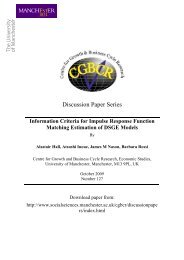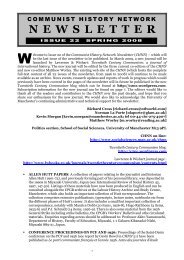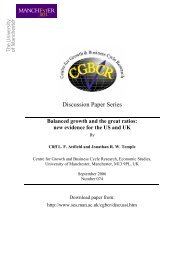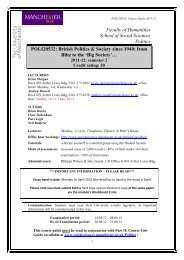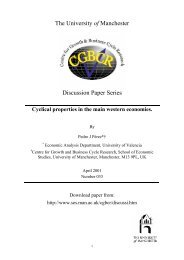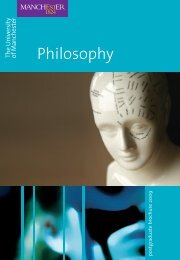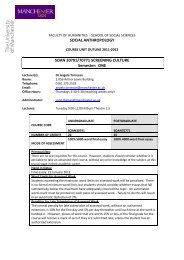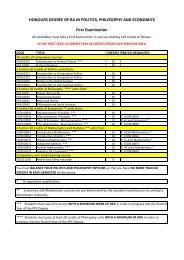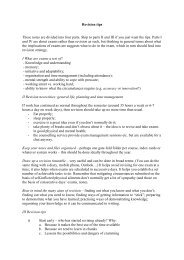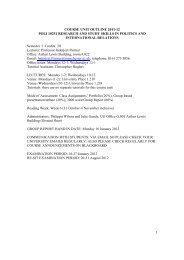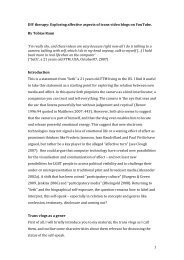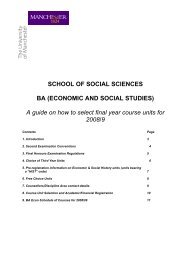second year course outlines 2012-2013 - School of Social Sciences ...
second year course outlines 2012-2013 - School of Social Sciences ...
second year course outlines 2012-2013 - School of Social Sciences ...
Create successful ePaper yourself
Turn your PDF publications into a flip-book with our unique Google optimized e-Paper software.
Questions to Consider:<br />
1. On p.299 Merleau-Ponty introduces the view <strong>of</strong> the ‘psychologist’, according to which the<br />
constant (true) shape and size <strong>of</strong> an object is that which is most frequently presents.<br />
Merleau-<br />
Ponty criticises the view by claiming that it presupposes that which it is supposed to explain.<br />
What exactly do you think he has in mind here? What is the account supposed to explain<br />
and<br />
does the ‘psychologist’ really presuppose it?<br />
2. Merleau-Ponty introduces the ‘Kantian’ view <strong>of</strong> shape and size constancy on p.300. What<br />
is<br />
this view supposed to be? What problems does Merleau-Ponty think that it faces?<br />
3. On p.302 Merleau-Ponty introduces his own account <strong>of</strong> shape and size constancy,<br />
according<br />
to which the constant is that which is associated with a norm. What is the view? How does it<br />
differ from the two accounts that Merleau-Ponty rejects?<br />
4. After a lengthy discussion <strong>of</strong> the relationship between ‘the thing lighted’, ‘the lighting’ and<br />
‘the<br />
organisation <strong>of</strong> the field’, Merleau-Ponty tells us the ‘true significance <strong>of</strong> the perceptual<br />
constancies’ (p.313). What do you think this ‘true significance’ is? Do you think that Merleau-<br />
Ponty has made a convincing case for the claim?<br />
22<br />
Lecture 8 (week 9): Embodiment I – the living body (Stein)<br />
Required Reading:<br />
Stein, E. 1917. On the Problem <strong>of</strong> Empathy. In Moran, D. & Mooney, T. The<br />
Phenomenology<br />
Reader. London: Routledge, 2002. [S]<br />
Recommended Reading:<br />
De Vignemont, F. 2007. Habeas Corpus: The sense <strong>of</strong> ownership <strong>of</strong> one’s own body. Mind<br />
and<br />
Language 22 [O]<br />
Further Reading:<br />
*Brewer, B. 1995. Bodily-Awareness and the Self. In J. L. Bermúdez, A. Marcel & N. Eilan,<br />
eds. The Body and the Self. Cambridge, MA: MIT Press.<br />
*Carman, T. 1999. The Body in Husserl and Merleau-Ponty. Philosophical Topics 27 (1999)<br />
Also available at http://ist-socrates.berkeley.edu/~hdreyfus/188_s05/pdf/Carman_Body.pdf<br />
Cassam, Q. Forthcoming. The Embodied Self. In S. Gallagher, ed. The Oxford Handbook<br />
<strong>of</strong><br />
the Self. Oxford: Oxford University Press.<br />
Also available at http://www2.warwick.ac.uk/fac/soc/philosophy/people/faculty/cassam/<br />
Gallagher, S. 1986. Lived Body and Environment. Research in Phenomenology 16 [O]<br />
Gallagher, S. 2003. Bodily-Awareness and Object Perception. Theoria et Historia<br />
Scientiarum:<br />
International Journal for Interdisciplinary Studies 7 (2003)<br />
Also available at http://pegasus.cc.ucf.edu/~gallaghr/<br />
MacIntyre, A. 2006. Edith Stein: A Philosophical Prologue, 1913-1922. Lanham: Rowman<br />
&<br />
Littlefield, Ch.9<br />
Martin, M. G. F. 1995. Bodily Awareness: A Sense <strong>of</strong> Ownership. In J. L. Bermúdez, A.<br />
Marcel<br />
& N. Eilan, eds. The Body and the Self. Cambridge, MA: MIT Press.<br />
*Merleau-Ponty, M. 1945. Phenomenology <strong>of</strong> Perception, translated by C. Smith. London:<br />
Routledge, 1962, Part 1 [S]<br />
Also available at www.archive.org<br />
23<br />
56



